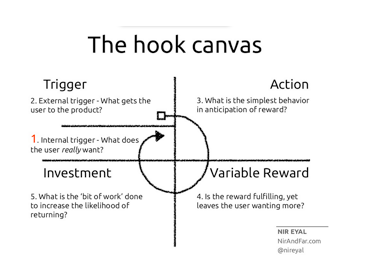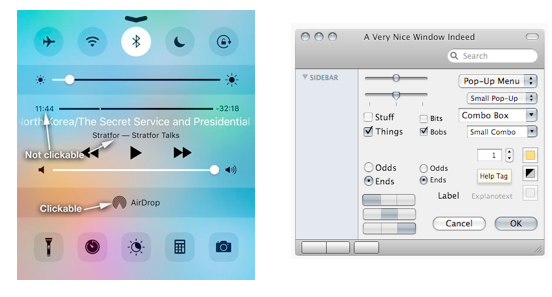Slave To The Ribbon: Four Tough Questions Every SaaS Designer Faces
My SaaS company, MeisterLabs, did its first usability test this year on our mindmapping product MindMeister. It was an eye-opening experience for a team that focuses on designing beautiful and easy to use software. It also forced us to think harder about our design philosophy and the hard questions that SaaS designers have to answer, one way or another.
1. Where do you land on the Snapchat-Word continuum?
Part of the usability test involved eye-tracking software that allowed us to see what parts of the interface people were looking at.
Despite all the innovations on interface design and UX that we’ve seen over the last years, it quickly became apparent that when people get stuck in software, they invariably look up. As in: they are checking the place where Microsoft Word or Outlook typically have a big multi-tab collection of text elements, icons and random drop down menus, also known as The Ribbon.
This, of course, means every SaaS designer needs to make a choice about where they want to position themselves: on the Snapchat end of the continuum, where users are supposed to figure things out and try to remember the secret combos that unlock certain pages and functionalities – or on the Microsoft end of things, where elements are expectedly found at the top of the interface.
In the more scientific terms of Don Norman’s classic “The Design of Everyday Things“, this is the battle between affordances (all the useful things that a product can do for a user) and the signifier (the interface elements that inform the user where they can push, pull, click or dial).
The light of a lamp is the affordance. The light switch is the signifier.
Industrial designers have decades of experience in frustrating users by hiding signifiers because they find minimalism more beautiful. The result is that you can’t find the light switch (hidden in the wallpaper), can’t open the kitchen cabinet (you have to push the edge, not pull), or you can’t get water from the tap (you have to wave at the tap in exactly the right spot).
In software, we’re evolving in the same direction. Quora user Ivan Boyko recently made a good case about the arrival of flat design, and how it ruined the accessibility of the web. Yes, flat design is prettier, but it also leaves less room for signifiers like the glass edge that showed you which buttons were clickable in iOS. The consequence is that today, you have to just know which buttons in iOS are clickable and which ones aren’t (Read the piece here, it’s interesting – pictures below taken from the original Quora post).
While I agree that flat design can make software a bit more challenging to use, I’m convinced that software design needs to err on the side of innovation and minimalism. Our industry is better off following the lead of bold companies like Snapchat or Apple. Ditching the headphone jack will be uncomfortable for a while. But it will be replaced by something simpler and leaner, forcing other companies to follow suit.
2. How does you interface grow with the user?
Then there’s the opposite problem: how do you avoid a design that is too simple for advanced users?
It’s quite clear that your software needs to be easy to understand for beginners. In the app industry, we know that a mere 16% of users will return to an app for a third try if the first two experiences were glitchy or unsuccessful. So you have to nail that first experience.
But new users will quickly become more sophisticated. They want to do more. They want to add images. They want to present their content to others or share their content. They want to create links between their content. Maybe they like your software so much that they’ll find use cases that push your interface to its very limits. A good problem to have, no doubt, but still a challenge we need to solve.
This is probably the hardest question for a software designer: How can I design software that meets the user with functionality at exactly the right moment in their customer journey?
This remains one of the most challenging questions for me personally: when you’re working on an app for more than a decade, the temptation can arise to complicate things – and maybe overcomplicate them.
One thing I do know is that software with different modes or states are not the answer. In my previous job, I had to help users with software systems. My first question was always: “Please tell me what mode your system is in?” People never knew the answer to that – they always needed to look it up.
3. What is the reward?
This is one question that you need to be able to answer clearly – whether you launched your product yesterday or you’ve been on the market for ten years.
In his bestselling book Hooked, entrepreneur and design expert Nir Eyal tries to explain how some companies create products that you just can’t put down. The golden standard are of course products like Facebook, which studies have proven our brain wants to check every 31 seconds.
What is it that makes you fall in love with these products? One of the main attractions of truly “habit-forming” products, Eyal concludes, is that they reward the actions they trigger.
Rewards can be anything. The only thing really required is that your user experiences a small, almost imperceptible boost of pleasure. In other words: the feeling you get when you finish assembling a piece of IKEA furniture.

For example, Eyal points out that LinkedIn provides users with reward when they input more details about themselves into the professional networking platform. A graphic pops up that illustrates how close to complete your profile is, building incentive in users to finish what they started. When you’ve provided enough information, LinkedIn lets you know that your profile has reached “All Star” status. Eyal says that the graphic increases the likelihood of users to open a premium account (and thus launch into the investment phase).
Knowing your product’s reward will allow you to reduce the time your user needs to get that very first boost – and reducing your ‘time to wow’ will increase the likelihood of bringing the user back a second time.
4. Are you future proof?
Finally, there’s the question: How will we survive the onslaught of new technologies that launch every day?
Augmented reality, virtual reality, artificial intelligence (the list goes on …) will change how users interact with content: they’ll be able to verbally access information (no more UI required!) or experience it in 3D (UI everywhere around you!).
The main difference seems to me the fact that the workspace will include the entire field of vision rather than a 24 inch slice of it. But that will probably be compensated partly by the fact that hand gestures aren’t as granular as the pointer of a mouse.
And at the same time the fundamentals will remain. We follow the 98 percent rule – in any productivity tool, about 98 percent of the UI should be reserved for the user’s content. This principle is at the core of MindMeister and our second product, MeisterTask. Stuffing the entire field of vision with possible action buttons will be just as confusing as offering a nine tab ribbon with 25 clickable items per tab. The more things change, the more they stay the same. I look forward to discussing software design with you in the comments or on Twitter: @mhollauf
